fuel TOYOTA VERSO S 2015 Service Manual
[x] Cancel search | Manufacturer: TOYOTA, Model Year: 2015, Model line: VERSO S, Model: TOYOTA VERSO S 2015Pages: 564, PDF Size: 18.47 MB
Page 461 of 564
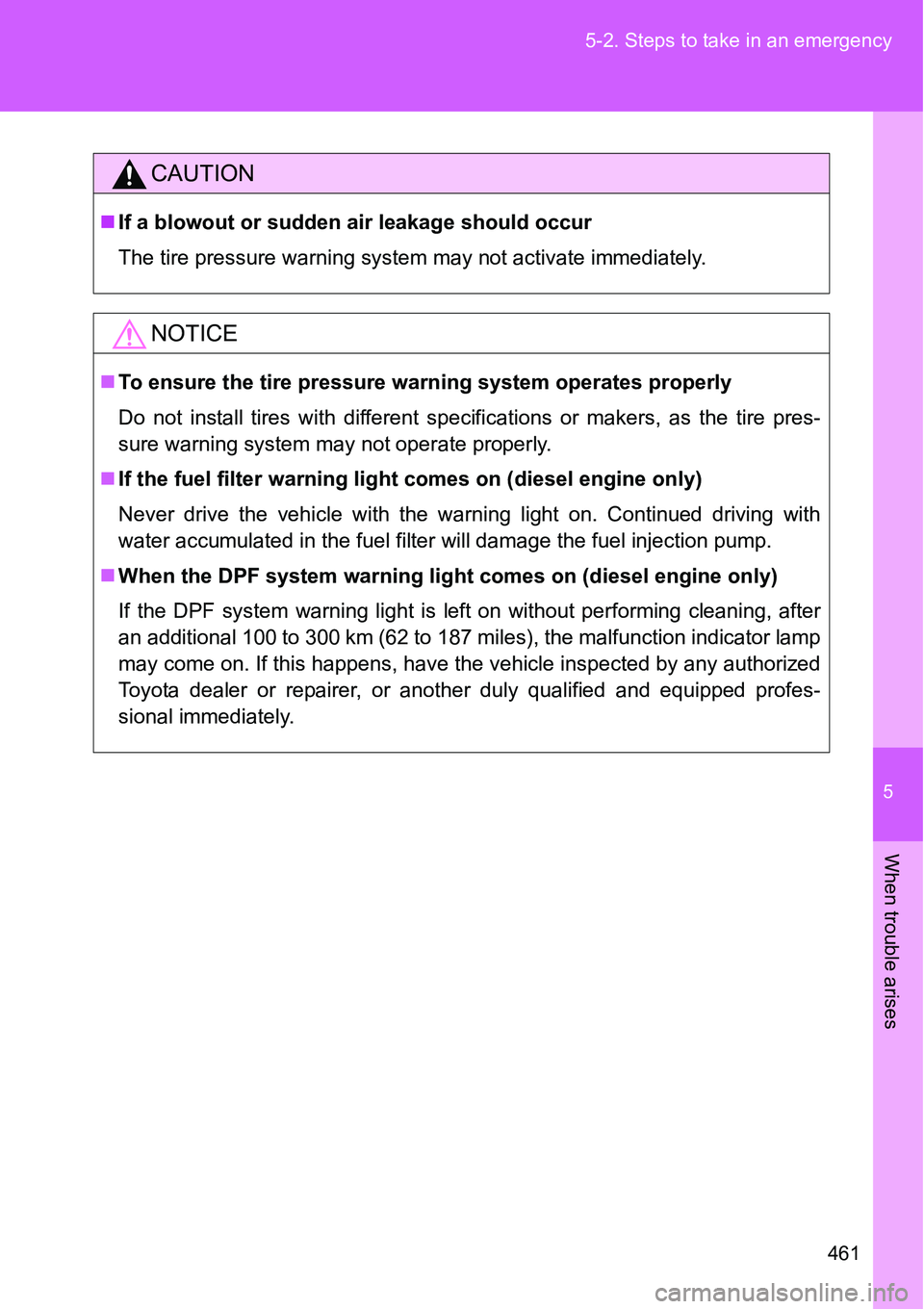
5
461 5-2. Steps to take in an emergency
When trouble arises
CAUTION
If a blowout or sudden air leakage should occur
The tire pressure warning system may not activate immediately.
NOTICE
To ensure the tire pressure warning system operates properly
Do not install tires with different specifications or makers, as the tire pres-
sure warning system may not operate properly.
If the fuel filter warning light comes on (diesel engine only)
Never drive the vehicle with the warning light on. Continued driving with
water accumulated in the fuel filter will damage the fuel injection pump.
When the DPF system warning light comes on (diesel engine only)
If the DPF system warning light is left on without performing cleaning, after
an additional 100 to 300 km (62 to 187 miles), the malfunction indicator lamp
may come on. If this happens, have the vehicle inspected by any authorized
Toyota dealer or repairer, or another duly qualified and equipped profes-
sional immediately.
Page 492 of 564
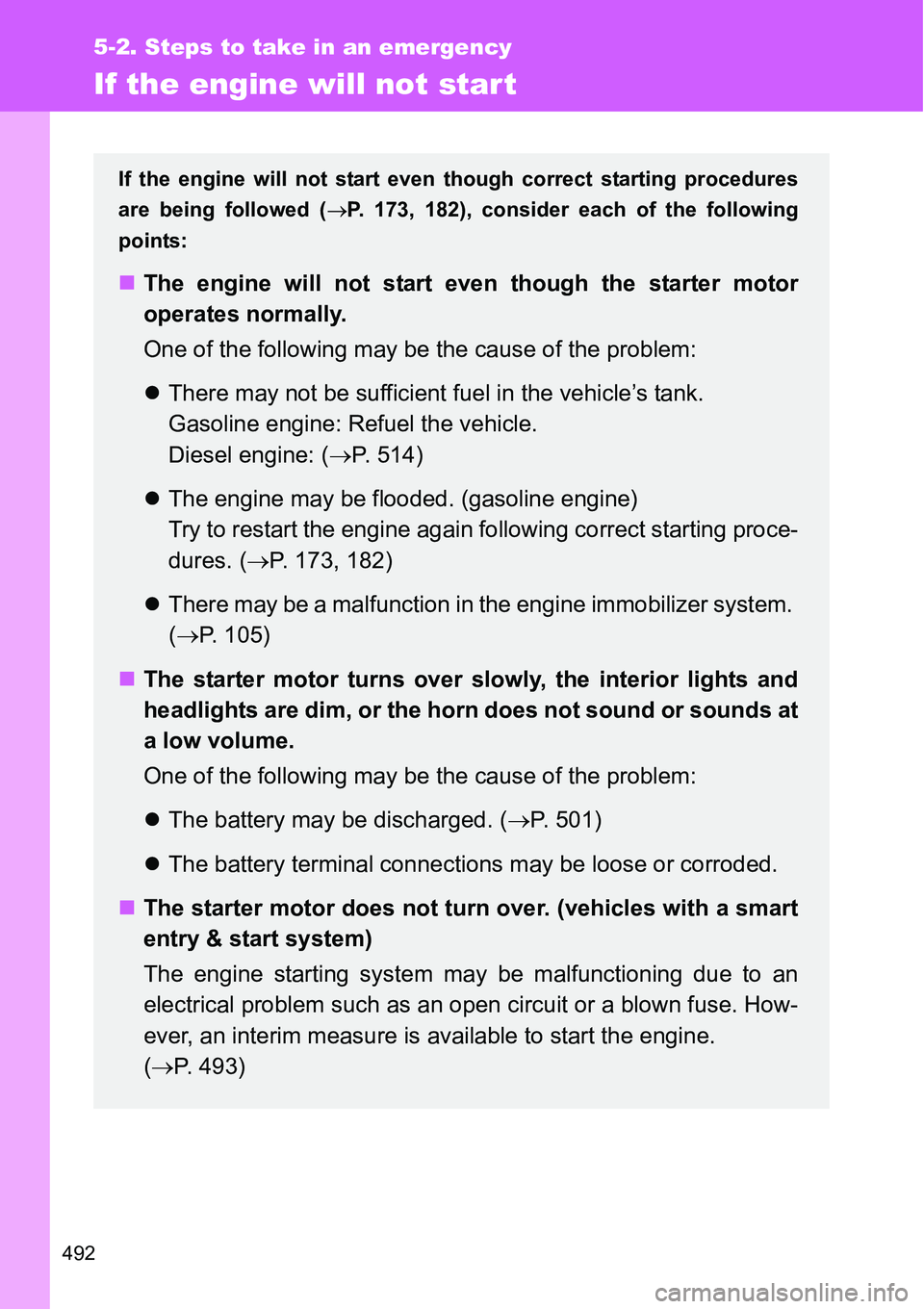
492
5-2. Steps to take in an emergency
If the engine will not start
If the engine will not start even though correct starting procedures
are being followed (P. 173, 182), consider each of the following
points:
The engine will not start even though the starter motor
operates normally.
One of the following may be the cause of the problem:
There may not be sufficient fuel in the vehicle’s tank.
Gasoline engine: Refuel the vehicle.
Diesel engine: (P. 514)
The engine may be flooded. (gasoline engine)
Try to restart the engine again following correct starting proce-
dures. (P. 173, 182)
There may be a malfunction in the engine immobilizer system.
(P. 105)
The starter motor turns over slowly, the interior lights and
headlights are dim, or the horn does not sound or sounds at
a low volume.
One of the following may be the cause of the problem:
The battery may be discharged. (P. 501)
The battery terminal connections may be loose or corroded.
The starter motor does not turn over. (vehicles with a smart
entry & start system)
The engine starting system may be malfunctioning due to an
electrical problem such as an open circuit or a blown fuse. How-
ever, an interim measure is available to start the engine.
(P. 493)
Page 514 of 564
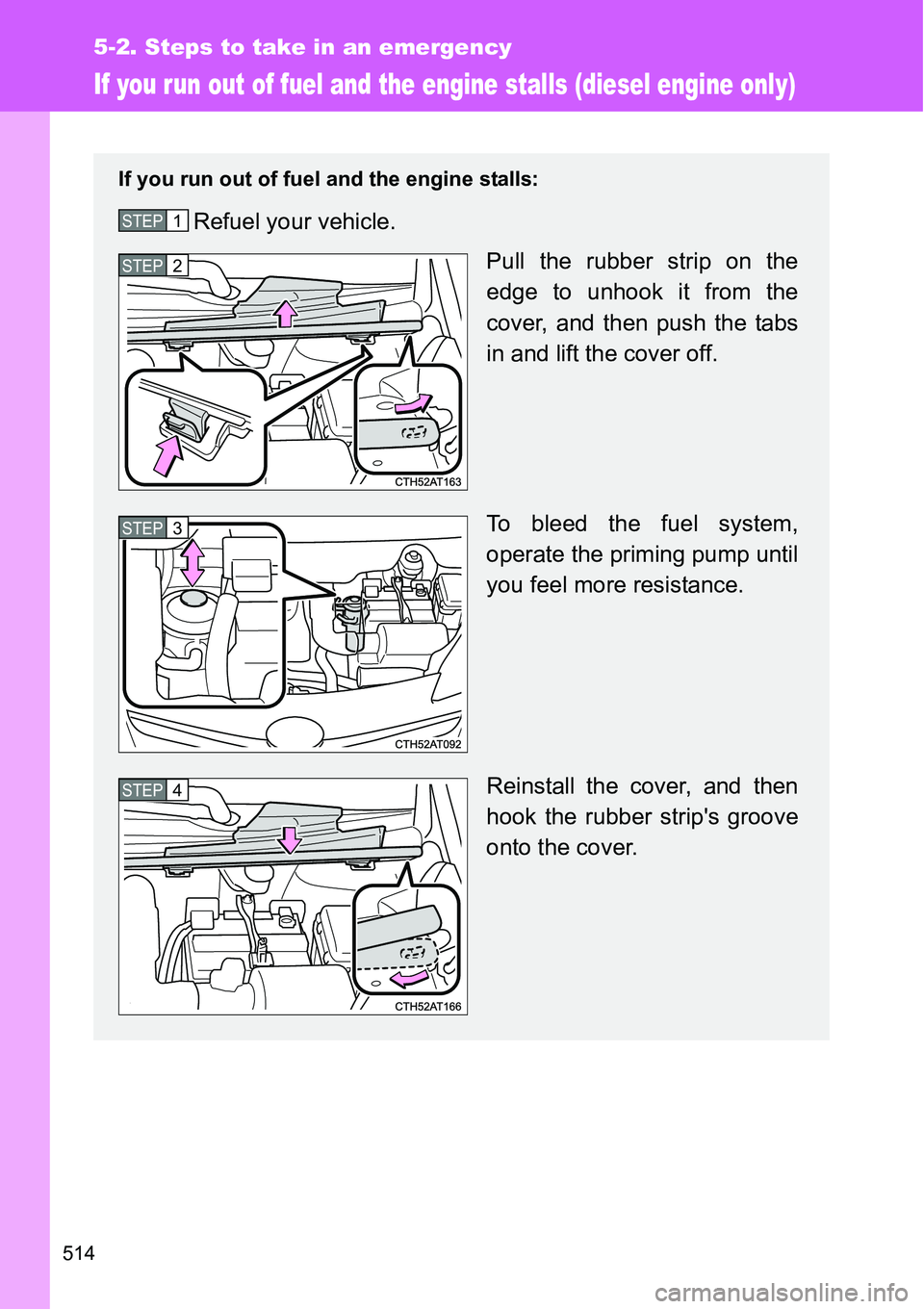
514
5-2. Steps to take in an emergency
If you run out of fuel and the engine stalls (diesel engine only)
If you run out of fuel and the engine stalls:
Refuel your vehicle.
Pull the rubber strip on the
edge to unhook it from the
cover, and then push the tabs
in and lift the cover off.
To bleed the fuel system,
operate the priming pump until
you feel more resistance.
Reinstall the cover, and then
hook the rubber strip's groove
onto the cover.STEP1
STEP2
STEP3
STEP4
Page 515 of 564
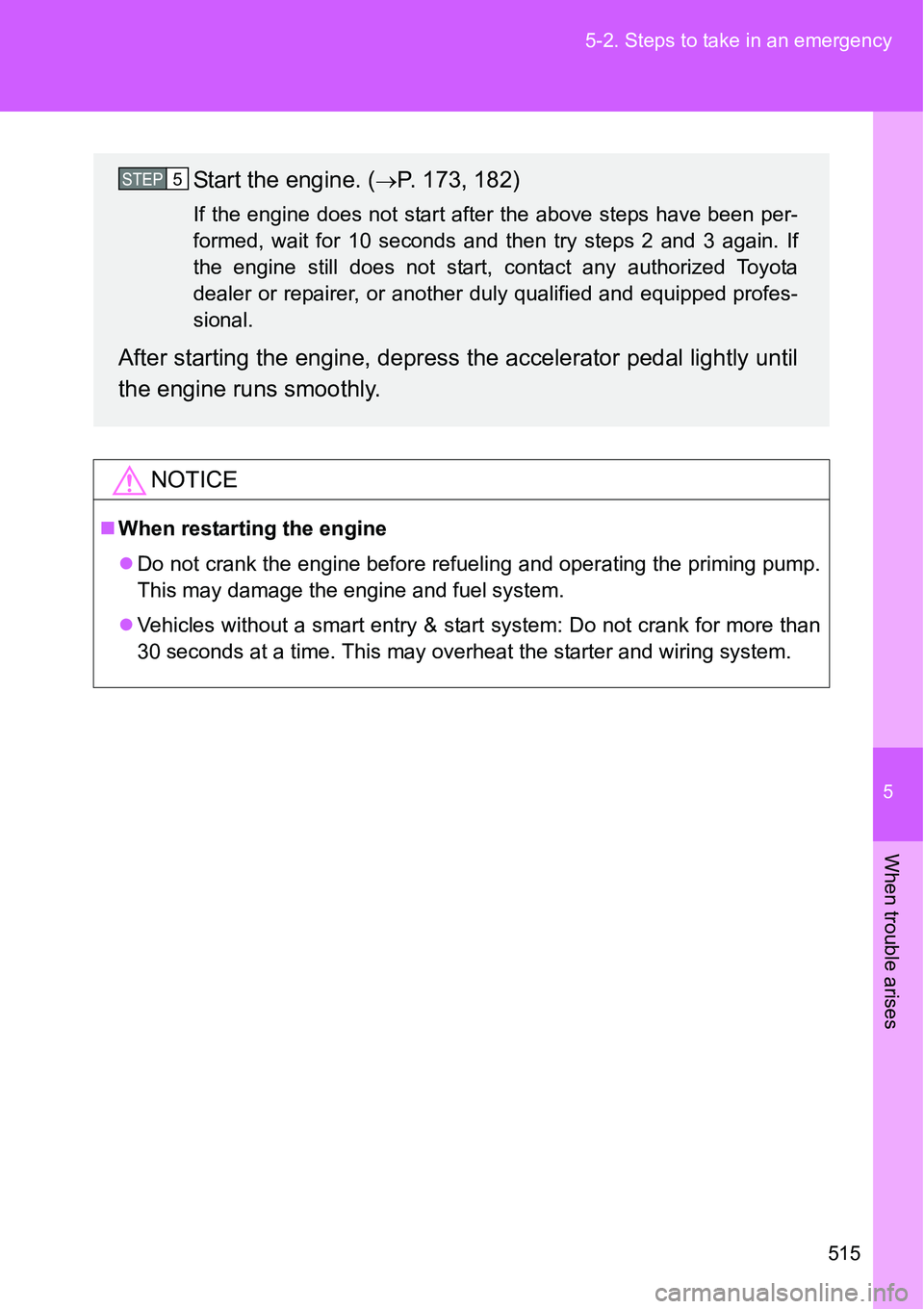
5
515 5-2. Steps to take in an emergency
When trouble arises
NOTICE
When restarting the engine
Do not crank the engine before refueling and operating the priming pump.
This may damage the engine and fuel system.
Vehicles without a smart entry & start system: Do not crank for more than
30 seconds at a time. This may overheat the starter and wiring system.
Start the engine. (P. 173, 182)
If the engine does not start after the above steps have been per-
formed, wait for 10 seconds and then try steps 2 and 3 again. If
the engine still does not start, contact any authorized Toyota
dealer or repairer, or another duly qualified and equipped profes-
sional.
After starting the engine, depress the accelerator pedal lightly until
the engine runs smoothly.
STEP5
Page 521 of 564
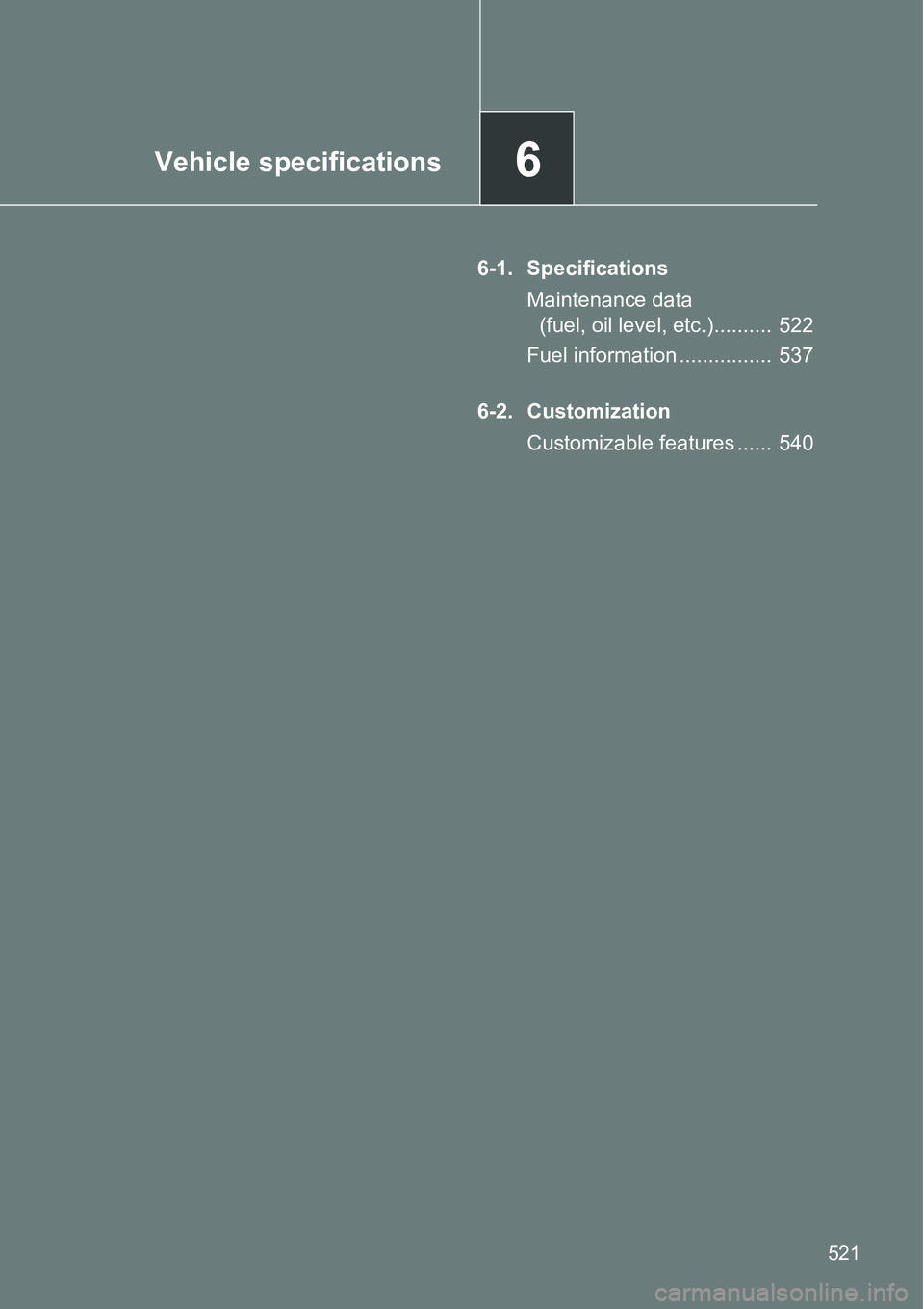
6Vehicle specifications
521
6-1. Specifications
Maintenance data
(fuel, oil level, etc.).......... 522
Fuel information ................ 537
6-2. Customization
Customizable features ...... 540
Page 522 of 564
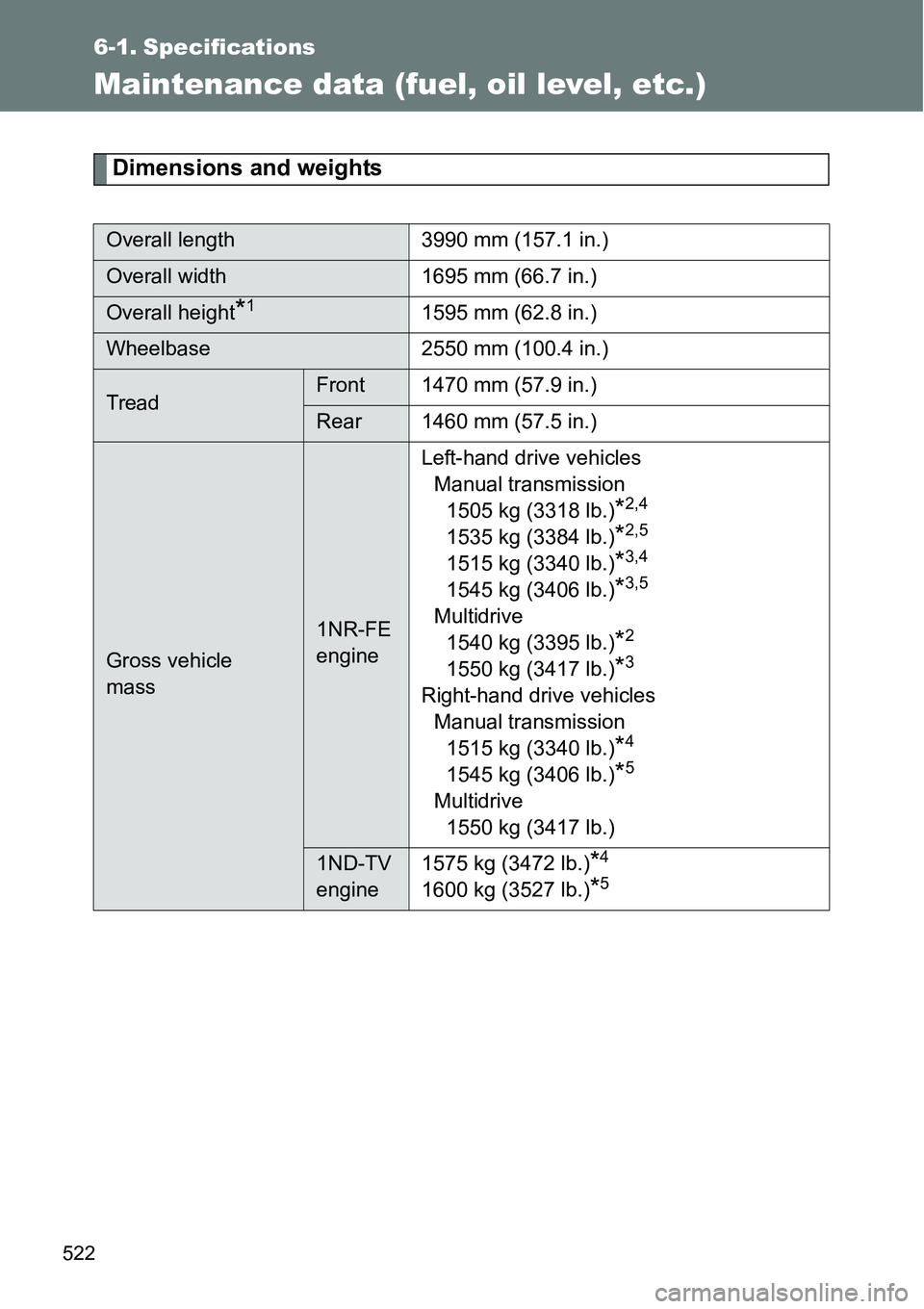
522
6-1. Specifications
Maintenance data (fuel, oil level, etc.)
Dimensions and weights
Overall length 3990 mm (157.1 in.)
Overall width 1695 mm (66.7 in.)
Overall height*11595 mm (62.8 in.)
Wheelbase 2550 mm (100.4 in.)
TreadFront 1470 mm (57.9 in.)
Rear 1460 mm (57.5 in.)
Gross vehicle
mass
1NR-FE
engineLeft-hand drive vehicles
Manual transmission
1505 kg (3318 lb.)
*2,4
1535 kg (3384 lb.)*2,5
1515 kg (3340 lb.)*3,4
1545 kg (3406 lb.)*3,5
Multidrive
1540 kg (3395 lb.)
*2
1550 kg (3417 lb.)*3
Right-hand drive vehicles
Manual transmission
1515 kg (3340 lb.)
*4
1545 kg (3406 lb.)*5
Multidrive
1550 kg (3417 lb.)
1ND-TV
engine1575 kg (3472 lb.)*4
1600 kg (3527 lb.)*5
Page 526 of 564
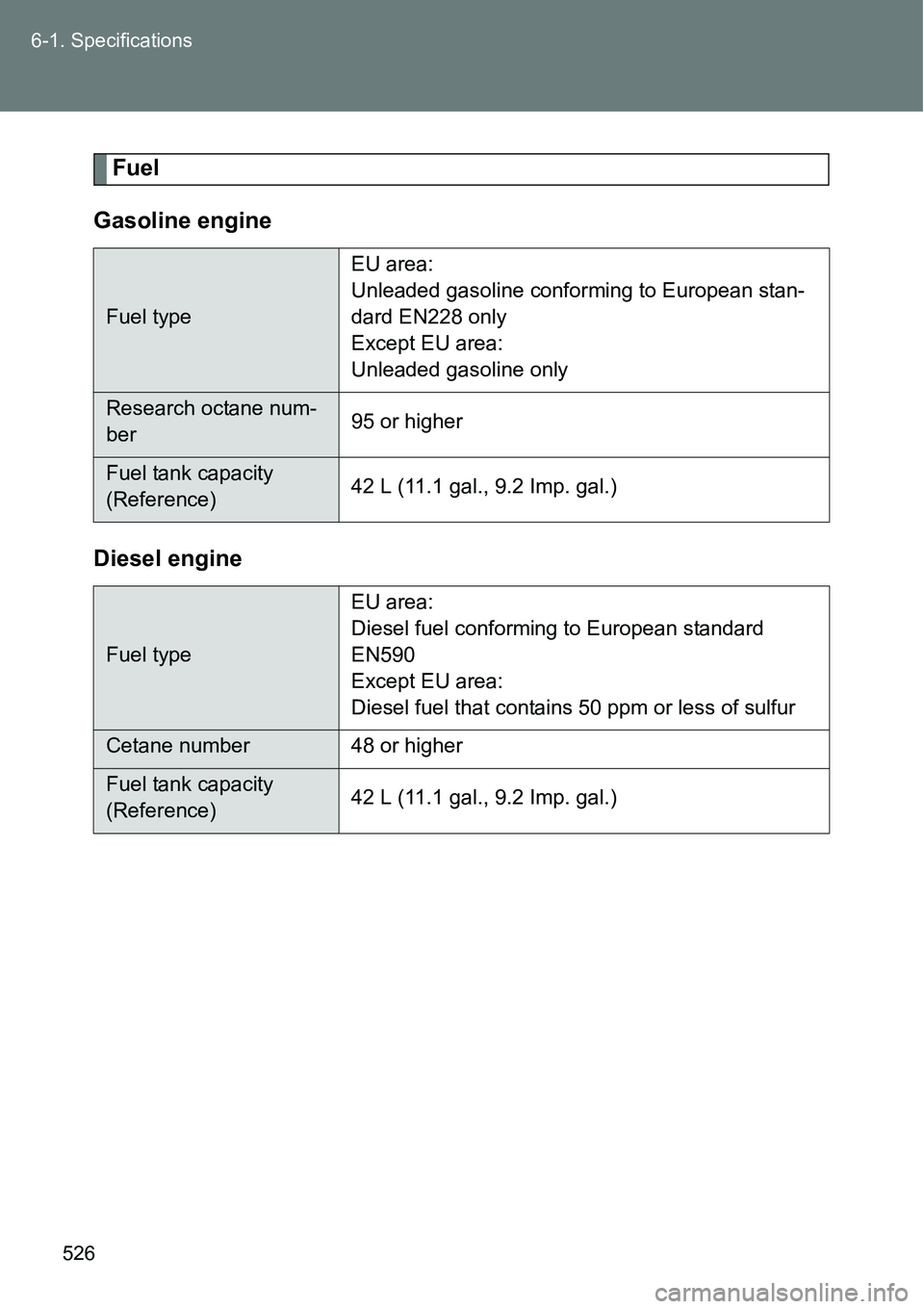
526 6-1. Specifications
Fuel
Gasoline engine
Diesel engine
Fuel typeEU area:
Unleaded gasoline conforming to European stan-
dard EN228 only
Except EU area:
Unleaded gasoline only
Research octane num-
ber95 or higher
Fuel tank capacity
(Reference)42 L (11.1 gal., 9.2 Imp. gal.)
Fuel typeEU area:
Diesel fuel conforming to European standard
EN590
Except EU area:
Diesel fuel that contains 50 ppm or less of sulfur
Cetane number 48 or higher
Fuel tank capacity
(Reference)42 L (11.1 gal., 9.2 Imp. gal.)
Page 528 of 564
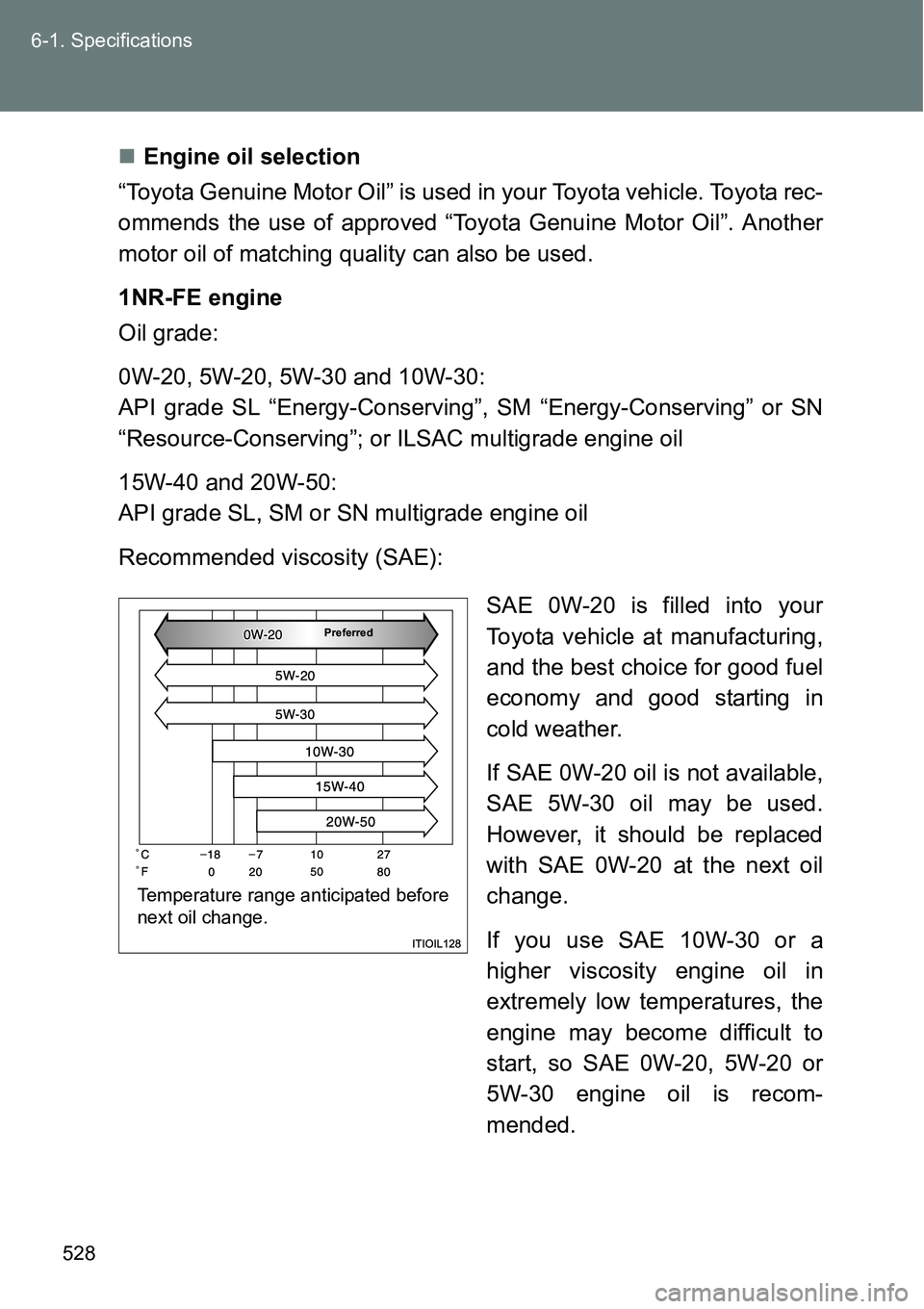
528 6-1. Specifications
Engine oil selection
“Toyota Genuine Motor Oil” is used in your Toyota vehicle. Toyota rec-
ommends the use of approved “Toyota Genuine Motor Oil”. Another
motor oil of matching quality can also be used.
1NR-FE engine
Oil grade:
0W-20, 5W-20, 5W-30 and 10W-30:
API grade SL “Energy-Conserving”, SM “Energy-Conserving” or SN
“Resource-Conserving”; or ILSAC multigrade engine oil
15W-40 and 20W-50:
API grade SL, SM or SN multigrade engine oil
Recommended viscosity (SAE):
SAE 0W-20 is filled into your
Toyota vehicle at manufacturing,
and the best choice for good fuel
economy and good starting in
cold weather.
If SAE 0W-20 oil is not available,
SAE 5W-30 oil may be used.
However, it should be replaced
with SAE 0W-20 at the next oil
change.
If you use SAE 10W-30 or a
higher viscosity engine oil in
extremely low temperatures, the
engine may become difficult to
start, so SAE 0W-20, 5W-20 or
5W-30 engine oil is recom-
mended.
Temperature range anticipated before
next oil change.
Preferred
Page 529 of 564
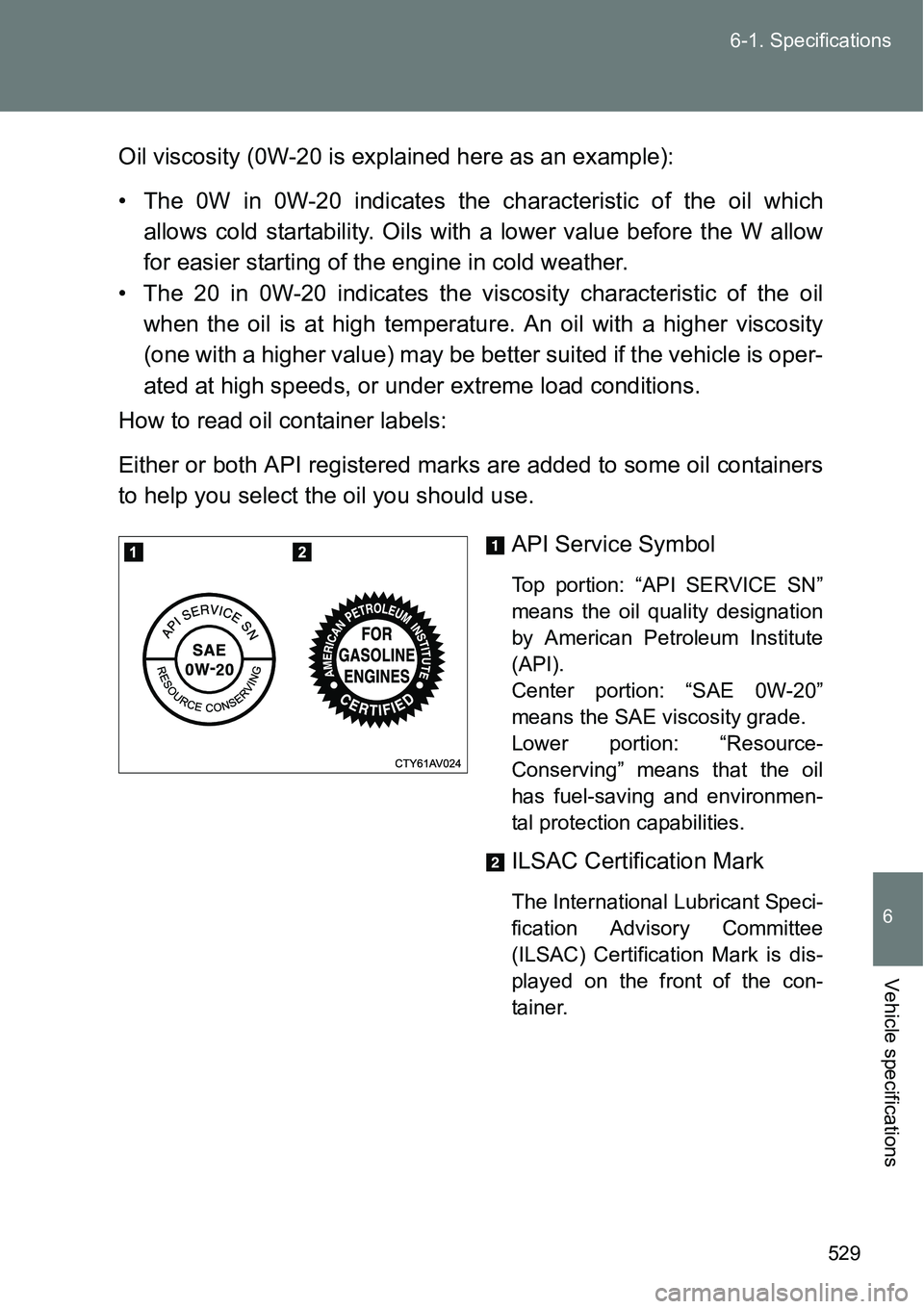
529 6-1. Specifications
6
Vehicle specifications
Oil viscosity (0W-20 is explained here as an example):
• The 0W in 0W-20 indicates the characteristic of the oil which
allows cold startability. Oils with a lower value before the W allow
for easier starting of the engine in cold weather.
• The 20 in 0W-20 indicates the viscosity characteristic of the oil
when the oil is at high temperature. An oil with a higher viscosity
(one with a higher value) may be better suited if the vehicle is oper-
ated at high speeds, or under extreme load conditions.
How to read oil container labels:
Either or both API registered marks are added to some oil containers
to help you select the oil you should use.
API Service Symbol
Top portion: “API SERVICE SN”
means the oil quality designation
by American Petroleum Institute
(API).
Center portion: “SAE 0W-20”
means the SAE viscosity grade.
Lower portion: “Resource-
Conserving” means that the oil
has fuel-saving and environmen-
tal protection capabilities.
ILSAC Certification Mark
The International Lubricant Speci-
fication Advisory Committee
(ILSAC) Certification Mark is dis-
played on the front of the con-
tainer.
Page 530 of 564
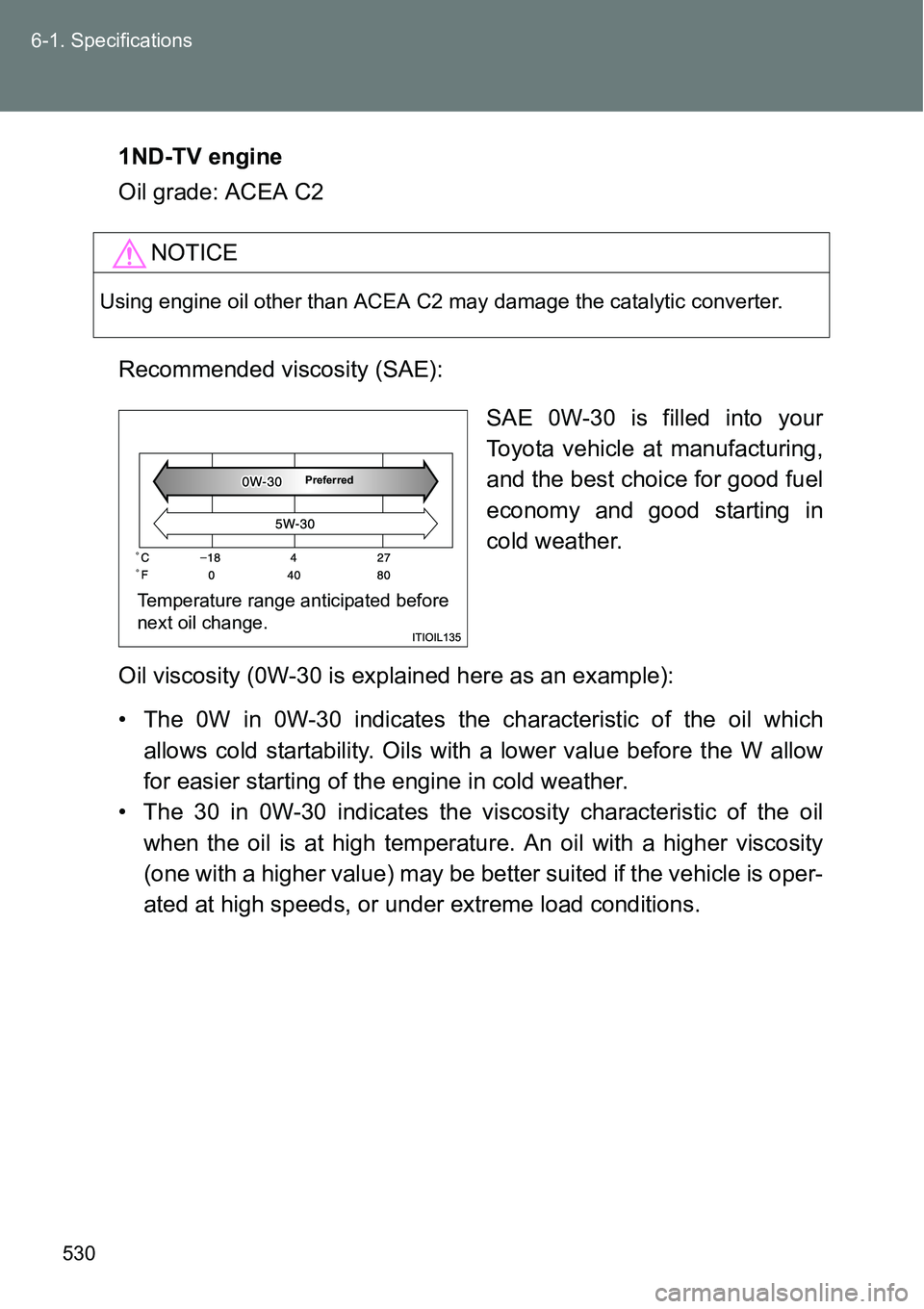
530 6-1. Specifications
1ND-TV engine
Oil grade: ACEA C2
Recommended viscosity (SAE):
SAE 0W-30 is filled into your
Toyota vehicle at manufacturing,
and the best choice for good fuel
economy and good starting in
cold weather.
Oil viscosity (0W-30 is explained here as an example):
• The 0W in 0W-30 indicates the characteristic of the oil which
allows cold startability. Oils with a lower value before the W allow
for easier starting of the engine in cold weather.
• The 30 in 0W-30 indicates the viscosity characteristic of the oil
when the oil is at high temperature. An oil with a higher viscosity
(one with a higher value) may be better suited if the vehicle is oper-
ated at high speeds, or under extreme load conditions.
NOTICE
Using engine oil other than ACEA C2 may damage the catalytic converter.
Temperature range anticipated before
next oil change.
Preferred